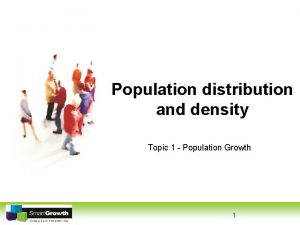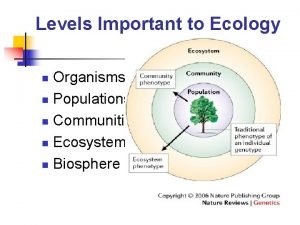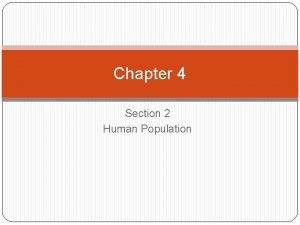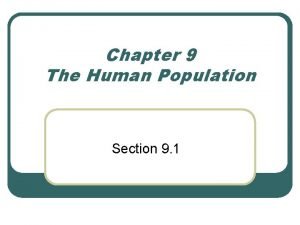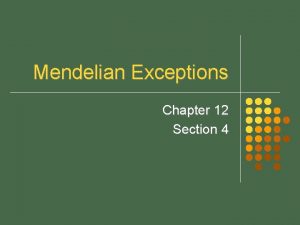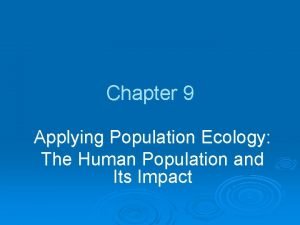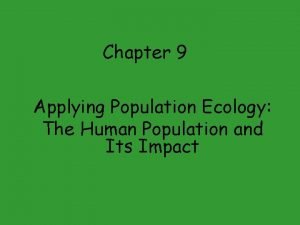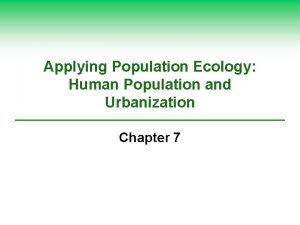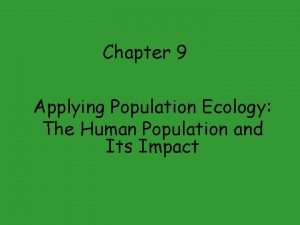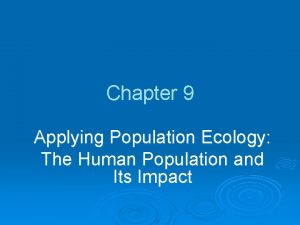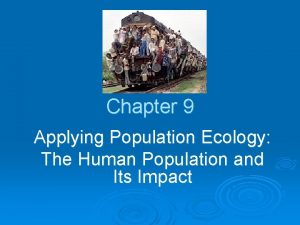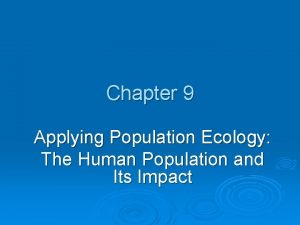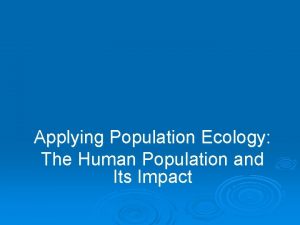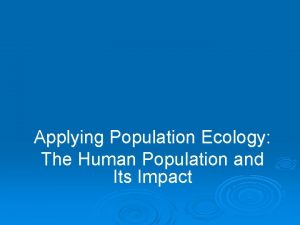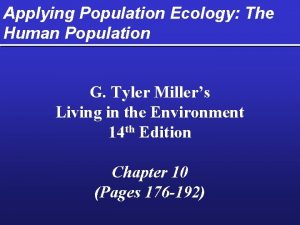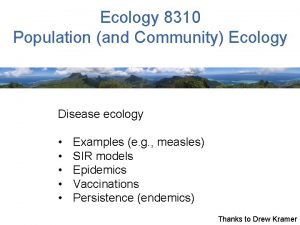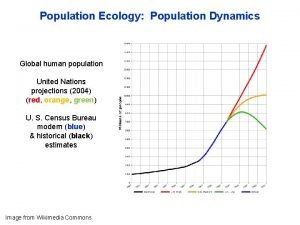Chapter 9 Applying Population Ecology The Human Population
















































- Slides: 48

Chapter 9 Applying Population Ecology: The Human Population and Its Impact

Chapter Overview Questions Ø What is the history of human population growth, and how many people are likely to be here by 2050? Ø How is population size affected by birth, death, fertility, and migration rates? Ø How is population size affected by percentages of males and females at each age level? Ø How can we slow population growth?

Video: Immigration Ø This video clip is available in CNN Today Videos for Environmental Science, 2004, Volume VII. Instructors, contact your local sales representative to order this volume, while supplies last.

Core Case Study: Is the World Overpopulated? Ø Much of the world’s population growth occurs in developing countries like China and India. Figure 9 -1

Core Case Study: Is the World Overpopulated? Ø Some argue that the planet has too many people. Ø Some feel that the world can support billions of more people due to technological advances. Ø There is a constant debate over the need to reduce population growth. l Must consider moral, religious, and personal freedom.

HUMAN POPULATION GROWTH: A BRIEF HISTORY Human Population has experienced rapid exponential growth (J curve) Ø 3 major factors explain the growth 1. Developed the ability to expand into new habitats and different climate zones 2. Increase in agriculture 3. Development of sanitation systems antibiotics and vaccines As a result death rates dropped sharply below birth rates Ø

Ø The rate of population growth has slowed but is still growing rapidly. Ø This is the result of keeping more people alive Ø Causes increased resource consumption person leading to environmental degradaton Ø Solution is reducing birth rates

Where Are We Headed? Ø We do not know how long we can continue increasing the earth’s carrying capacity for humans. l l l There are likely to be between 7. 2 -10. 6 billion people on earth by 2050. 97% of growth in developing countries living in acute poverty. What is the optimum sustainable population of the earth based on the cultural carrying capacity?

Where are we Headed? Ø No one knows how close we are to the environmental limits but natural capital is slowly degrading

Where Are We Headed? Ø U. N. world population projection based on women having an average of 2. 5 (high), 2. 0 (medium), or 1. 5 (low) children. Figure 9 -2

High 10. 6 Medium Population (billions) Low Medium 8. 9 Low 7. 2 Year Fig. 9 -2, p. 173

FACTORS AFFECTING HUMAN POPULATION SIZE Ø Population increases because of births and immigration and decreases through deaths and emigration. Ø Instead of using raw numbers, crude birth rates and crude death rates are used (based on total number of births or deaths per 1, 000 people in a population).

FACTORS AFFECTING HUMAN POPULATION SIZE Ø Average crude and birth rates for various groupings of countries in 2006. Figure 9 -3

FACTORS AFFECTING HUMAN POPULATION SIZE Ø The world’s 10 most populous countries in 2006 with projections in 2025. Figure 9 -4

Declining Fertility Rates: Fewer Babies per Women The average number of children that a woman bears has dropped sharply. Ø This decline is not low enough to stabilize the world’s population in the near future. Ø Fertility= number of children born to a woman during her lifetime Ø l l Replacement-level fertility: the number of children a couple must bear to replace themselves. Total fertility rate (TFR): the average number of children a woman has during her reproductive years.

Declining Fertility Rates: Fewer Babies per Women Ø The replacement level to sustain a population is 2. 0 children. Ø In 2006, the average global Total Fertility Rate was 2. 7 children per woman. l l 1. 6 in developed countries (down from 2. 5 in 1950). 3. 0 in developing countries (down from 6. 5 in 1950).

Case Study: Fertility and Birth Rates in the United States Period of high birth rates (baby boom) 19461964 Baby bust followed due to delayed marriage, contraceptive use, and abortion Decline in the rate of population growth but country’s population is still growing Population increase due to birth rates outnumbering deaths and high immigration

Case Study: Fertility and Birth Rates in the United States Ø In 2006, the total fertility rate in the United States was slightly > 2. 0 Figure 9 -5

Case Study: Fertility and Birth Rates in the United States Ø The baby bust that followed the baby boom was largely due to delayed marriage, contraception, and abortion. Figure 9 -6

Births per thousand population Demographic transition End of World War II Depression Baby boom Baby bust Echo baby boom Year Fig. 9 -6, p. 175

47 years Life expectancy 77 years 8% Married women working outside the home 81% 15% High school graduates 83% 10% Homes with flush toilets Homes with electricity Living in suburbs Hourly manufacturing job wage (adjusted for inflation) Homicides per 100, 000 people 98% 2% 99% 10% $3 1. 2 52% 1900 2000 $15 5. 8 Fig. 9 -7, p. 176

Factors Affecting Birth Rates and Fertility Rates Ø The number of children women have is affected by: l l l l The cost of raising and educating them. Availability of pensions. Urbanization. Education and employment opportunities. Infant deaths. Marriage age. Availability of contraception and abortion.

Factors Affecting Death Rates Ø Death rates have declined because of: l l Increased food supplies, better nutrition. Advances in medicine. Improved sanitation and personal hygiene. Safer water supplies. Ø U. S. infant mortality is higher than it could be (ranked 46 th world-wide) due to: l l l Inadequate pre- and post-natal care for poor. Drug addiction. High teenage birth rate.

Ø Life Expectancy = Average number of years a newborn can be expected to live. Ø Infant Mortality rate= the number of babies out of every 1, 000 born who die before reaching first birthday. Infant mortality is viewed as an indicator of quality of life of a society because it reflects nutrition and healthcare.

Case Study: U. S. Immigration Since 1820, the U. S. has admitted almost twice as many immigrants and refugees as all other countries combined. Ø 1820 -1960= legal immigrants coming from Europe Ø Since 1960 coming from latin America & Asia Ø Figure 9 -8

How Would You Vote? To conduct an instant in-class survey using a classroom response system, access “Join. In Clicker Content” from the Power. Lecture main menu for Living in the Environment. Ø Should legal immigration into the United States (or the country where you live) be reduced? l l a) Yes: Because of threats of terrorism and the burden on the economy, immigration should be reduced. b) No. Humane efforts should be made to curtail illegal immigration, but our economy needs legal immigrants.

POPULATION AGE STRUCTURE Ø The number of people in young, middle, and older age groups determines how fast populations grow or decline. Ø The number of people younger than age 15 is the major factor determining a country’s population growth. Ø Changes in the distribution of a country’s age groups have long-lasting economic and social impacts.

POPULATION AGE STRUCTURE Ø Populations with a large proportion of its people in the preproductive ages 1 -14 have a large potential for rapid population growth. Figure 9 -9

Age Structure Ø Comparing the structures of different countries to one another, you can infer differences in the social conditions and growth rate Ex. Broad Base can indicate High infant mortality rate Poor health care Lack of opportunities for women

POPULATION AGE STRUCTURE Ø 32% of the people in developing countries were under 15 years old in 2006 versus only 17% in developed countries. Figure 9 -10

Developed Countries Female Age Male Population (millions) Fig. 9 -10 a, p. 179

Developed Countries Female Age Male Population (millions) Fig. 9 -10 b, p. 179

POPULATION AGE STRUCTURE Ø Today, baby boomers make up nearly half of all adult Americans and dominate the populations demand for goods and services. Figure 9 -11

POPULATION AGE STRUCTURE Ø About 14% of the world’s population live in countries with stabilizing or declining populations. Ø Rapid population decline can lead to longlasting economic and social problems. Ø Death from AIDS can disrupt a country’s social and economic structure by removing significant numbers of young adults. Ø Global again may help promote peace.

POPULATION AGE STRUCTURE Ø Age structure predictions based on a medium fertility projection. Ø The cost of an aging population will strain the global economy. Figure 9 -12

POPULATION AGE STRUCTURE Ø Some problems with rapid population decline. Ø Which of these problems do you believe are the most important? Figure 9 -13

• Can threaten economic growth • Less government revenues with fewer workers • Less entrepreneurship and new business formation • Less likelihood for new technology development • Increasing public deficits to fund higher pension and healthcare costs Fig. 9 -13, p. 182

SOLUTIONS: INFLUENCING POPULATION SIZE Ø Demographic Transition: As countries become economically developed, their birth and death rates tend to decline. l l l Preindustrial stage: little population growth due to high infant mortality. Transitional stage: industrialization begins, death rates drops and birth rates remain high. Industrial stage: birth rate drops and approaches death rate.

SOLUTIONS: INFLUENCING POPULATION SIZE Ø Generalized model of demographic transition. l Some developing countries may have difficulty making the demographic transition. Figure 9 -14

Stage 1 Preindustrial Stage 2 Transitional Stage 3 Industrial Stage 4 Postindustrial Relative population size Birth rate and death rate (number per 1, 00 per year) High Birth rate Death rate Low Total population Increasing Very high Decreasing Low Zero Negative Low Growth rate over time Fig. 9 -14, p. 183

SOLUTIONS: INFLUENCING POPULATION SIZE Ø Family planning has been a major factor in reducing the number of births and abortions throughout most of the world. Ø Women tend to have fewer children if they are: l l l Educated. Hold a paying job outside the home. Do not have their human right suppressed.

SOLUTIONS: INFLUENCING POPULATION SIZE Ø The best way to slow population growth is a combination of: l l l Investing in family planning. Reducing poverty. Elevating the status of women.

SLOWING POPULATION GROWTH IN INDIA AND CHINA Ø For more than five decades, India has tried to control its population growth with only modest success. Ø Since 1970, China has used a governmentenforced program to cut its birth rate in half and sharply reduce its fertility rate.

Percentage of world population Population 17% Illiteracy (% of adults) Infant mortality rate 47% 17% Population under age 15 (%) Total fertility rate 36% 20% 1. 6% 0. 6% 2. 9 children per women (down from 5. 3 in 1970) 1. 6 children per women (down from 5. 7 in 1972) 58 27 62 years 70 years Life expectancy Percentage living below $2 per day GDP PPP per capita 20% 1. 1 billion 1. 3 billion 1. 4 billion 1. 6 billion Population (2050) (estimated) Population growth rate (%) India China 80 47 $3, 120 $5, 890 Fig. 9 -15, p. 186

India’s Failed Family Planning Program Ø Poor planning. Ø Bureaucratic inefficiency. Ø Low status of women. Ø Extreme poverty. Ø Lack of administrative financial support. Ø Disagreement over the best ways to slow population growth.

China’s Family Planning Program Ø Currently, China’s TFR is 1. 6 children per women. Ø China has moved 300 million people out of poverty. Ø Problems: l l l Strong male preference leads to gender imbalance. Average population age is increasing. Not enough resource to support population.

HUMAN ASPECTS ON NATURAL SYSTEMS Ø We have used technology to alter much of the rest of nature in ways that threaten the survival of many other species and could reduce the quality of life for our own species. Figure 9 -17

Natural Capital Degradation Altering Nature to Meet Our Needs Reduction of biodiversity Increasing use of the earth's net primary productivity Increasing genetic resistance of pest species and disease-causing bacteria Elimination of many natural predators Deliberate or accidental introduction of potentially harmful species into communities Using some renewable resources faster than they can be replenished Interfering with the earth's chemical cycling and energy flow processes Relying mostly on polluting fossil fuels Fig. 9 -17, p. 188
 Chapter 4 section 1 population dynamics
Chapter 4 section 1 population dynamics Study guide chapter 4 section 1 population dynamics
Study guide chapter 4 section 1 population dynamics Population ecology section 1 population dynamics
Population ecology section 1 population dynamics Population ecology section 1 population dynamics
Population ecology section 1 population dynamics Chapter 53 population ecology
Chapter 53 population ecology Equilibrial life history
Equilibrial life history Chapter 4 population ecology answer key
Chapter 4 population ecology answer key Chapter 53 population ecology
Chapter 53 population ecology Chapter 4 section 2 human population answer key
Chapter 4 section 2 human population answer key Chapter 53 population ecology
Chapter 53 population ecology Logistic growth ecology definition
Logistic growth ecology definition Logistic growth equation population ecology
Logistic growth equation population ecology Population vs community ecology
Population vs community ecology Population vs community ecology
Population vs community ecology Concept 3 population ecology
Concept 3 population ecology Survivorship curve def
Survivorship curve def Population characteristic
Population characteristic Population characteristics ecology
Population characteristics ecology Ideal population growth curve
Ideal population growth curve Population definition ecology
Population definition ecology Population ecology
Population ecology Population ecology
Population ecology Difference between formal and functional region
Difference between formal and functional region The geometric arrangement of objects in space
The geometric arrangement of objects in space Ehp occupational therapy
Ehp occupational therapy Human ecology
Human ecology P what
P what Chapter 4 section 2 human population answer key
Chapter 4 section 2 human population answer key Chapter 9 the human population section 1
Chapter 9 the human population section 1 Andalusian chicken incomplete dominance
Andalusian chicken incomplete dominance Chapter 12 lesson 2 applying mendels principles
Chapter 12 lesson 2 applying mendels principles 11.2 applying mendel's principles
11.2 applying mendel's principles Chapter 33 applying paints and enamels
Chapter 33 applying paints and enamels Chapter 12 lesson 2 applying mendels principles
Chapter 12 lesson 2 applying mendels principles Chapter 17:10 providing first aid for specific injuries
Chapter 17:10 providing first aid for specific injuries Chapter 3 applying learning theories to healthcare practice
Chapter 3 applying learning theories to healthcare practice 8.3 human needs
8.3 human needs Chapter 8 human needs and human development
Chapter 8 human needs and human development Marine ecology
Marine ecology Study guide chapter 3 section 1 community ecology
Study guide chapter 3 section 1 community ecology Chapter 56 conservation biology and restoration ecology
Chapter 56 conservation biology and restoration ecology Chapter 55 ecosystems and restoration ecology
Chapter 55 ecosystems and restoration ecology Chapter 54 community ecology
Chapter 54 community ecology Chaparral climograph
Chaparral climograph Chapter 5 evolution and community ecology answer key
Chapter 5 evolution and community ecology answer key Chapter 2 section 1 organisms and their relationships
Chapter 2 section 1 organisms and their relationships Principles of ecology chapter 2 section 1 answer key
Principles of ecology chapter 2 section 1 answer key Principles of ecology chapter 2
Principles of ecology chapter 2 Chapter 54 community ecology
Chapter 54 community ecology




















